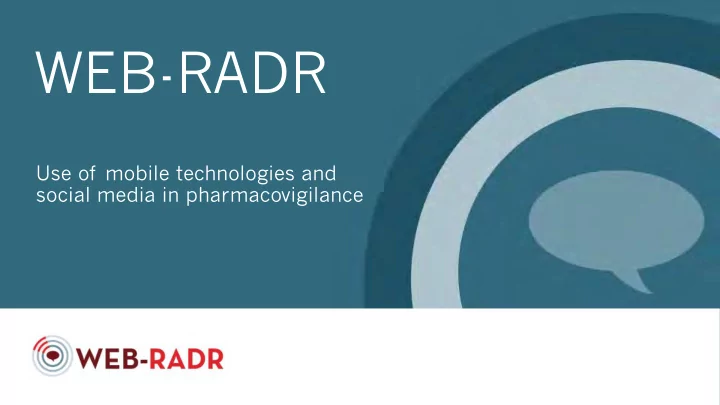

WEB-RADR Use of mobile technologies and social media in pharmacovigilance
Smartphones and mobile apps 1.3 million apps available for • 1.75 billion smartphones in use • android users (1.2 million for worldwide iOS) 34.6 million in the UK • Around 6,000 health related apps • 62% of UK adults have a • NHS has its own app store • smartphone 24% also have a tablet •
Smartphones and mobile apps 1.6 million apps available for • 2.6 billion smartphones in use • android users (1.5 million for worldwide iOS) 37.8 million in the UK • Around 100,000 health related • apps 76% of UK adults have a • smartphone NHS has its own app store • 54% of households have a tablet •
Social media 1.49 billion active Facebook users 304 million active Twitter • • users 1.3 billion on mobile devices • 80% active on mobile • 65% log on every day • 500 million tweets per day • 35-54 largest age group • worldwide
WEB-RADR Consortium
High level aims and deliverables App Patient/ HCP needs analysis for mobile reporting and receipt of feedback during first year • Initial mobile app developed by April 2015; enhancement based on user feedback • throughout the project Off the shelf package implementation guide and interface available by the end of the project • Social media Novel techniques for identification of safety data and signal detection/ evaluation in social • media between throughout the project Social media analysis platform for the whole pharmacovigilance community by project close • Scientific impact evaluation & policy Surveillance and communications policies based on robust scientific evaluation of the tools • developed
Mobile Apps UK App Launched in July by • the Minister for Life Sciences Uptake is free to users • Dutch and Croatian apps in • development Downloads: • - iOS: 1030 - Android: 406 (as of 1 st October 2015) Reports: • - 39 Received (as of 16 th October 2015)
User evaluation Identifying barriers and facilitators for • using mobile app - To report ADRs - For accessing drug (safety) information Segmenting target groups • - Patients: adolescents, orphan disease populations, elderly - Healthcare professionals Targeted & differential app development • Validate in a range of settings • - Lab based - Clinical settings - Surveys Comparison to patient notes •
Feedback
Enhancement requests Unified login details • Push notifications • Enhancements to ADR details • More news content • Devices, Defects & • Counterfeits Additional Monitoring status • All news option • Minor tweaks • Barcode scanning •
What is the value of social media? Massive volume of discussion & Expectatio patient- n that reported someone is outcomes Unique stream listening Not intended to of intelligence supplant that is not traditional necessarily post-marketing captured in surveillance other data sources 11
Social Media Monitoring Platform Social media monitoring and • analytics platform Collects, aggregates, • classifies and visualizes public content from social media platforms describing adverse drug events Designed to support post- • marketing drug safety surveillance
Data flow: Data acquisition Social ¡Data ¡ • Public posts are acquired from Facebook, Twitter and patient forums via Application Programming Interfaces (APIs), using medical product names as search terms.
Data flow: Filtering • An algorithm trained to recognize language that describes a possible adverse drug reaction classifies and filters the posts using a vernacular-to- regulatory dictionary.
Data flow: Curation Social ¡Data ¡ • Human curation further trains the classifier, improves symptom dictionary, ensures symptoms are attributed to appropriate product, and removes false positives.
Data flow: Dissemination Social ¡Data ¡ Filtering ¡ Curation ¡ Dashboard ¡ • Aggregate and granular data are disseminated and visualized in an interactive, web- based dashboard.
Where are we now? 188 products identified: • - 13 therapeutic areas - 17 additional monitoring products - 5 orphan drugs - 15 biological medicines Begun data collection: • - 1,215,523 posts mentioning those products - 1,189,534 removed using “spam” filters - 25,989 “meaningful mentions” - 318 Proto-AEs Initial dashboard developed • Gold standard reference set • developed to enhance analytics
What might we find? Consortium keen for global • applicability Concordance with existing • data? What else can social media • tell us - Abuse? - Misuse? - Counterfeit? Geo pharmacovigilance a • possibility?
Scientific Impact evaluation Essential Aim: To determine whether novel media applications (apps and social media) add value to existing pharmacovigilance methodologies • Add information to the established safety profile of a medicine • Enable earlier detection of new signals • Reveal new patterns or trends in reporting • Provide a means for geo- pharmacovigilance
Communication Desire Response Well understood that safety • Need to assess the reaction • messages may not reach of the public to receiving a those need them in the timeframes desired response - Discussions with Healthcare professionals? - Via a mobile app? - Healthcare professional letters? - Via Twitter? - Updates to product information? - Online information? - Via Facebook? Ability to put such messages • Recommendations to be • directly in to the pockets of developed based on robust patients seems like a hugely powerful way to science, and relevant legal/ communication ethical considerations Responsibility to test that • messages to have the desired impact; impact of language used?
More Questions for Pharmacovigilance Who owns the data? • Legal and/or ethical • responsibilities Is consent needed? • What are the legal & ethical • implications? Do we listen only or intervene – • when? Health responsibility vs privacy •
Summary • Traditional ADR reporting and signal management methods are changing • New technologies offer new possibilities • WEB-RADR seeks to investigate, develop tools and recommend policy • Watch this space……
Thank you. Questions? Email: Phil.Tregunno@mhra.gsi.gov.uk WEB-RADR@mhra.gsi.gov.uk Website: http://web-radr.eu Twitter: @WEBRADR
Recommend
More recommend